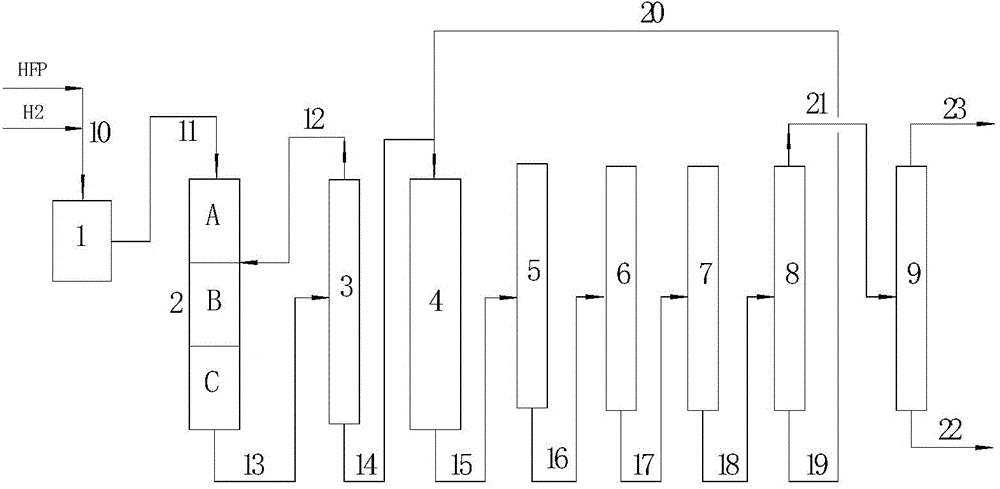Method for co-production of 2,3,3,3-tetrafluoropropene and 1,3,3,3-tetrafluoropropene
一种四氟丙烯、六氟丙烯的技术,应用在含氟烯烃的制备领域,能够解决产品成本高、工艺路线长、反应器腐蚀等问题,达到投资小、简化工艺流程、转化率高的效果
- Summary
- Abstract
- Description
- Claims
- Application Information
AI Technical Summary
Problems solved by technology
Method used
Image
Examples
Embodiment 1
[0040] 200ml Pd / AlF 3 Catalyst (the mass percentage composition of Pd is 0.3%) loads the C section of reactor, 300ml chromium-aluminum-zinc catalyst (by mass percentage, catalyst is composed of: 5% of chromium oxide, 90% of aluminum oxide, 5% of zinc oxide ) into section B, 200mlPd / Al 2 o 3 Catalyst (0.3% by mass of Pd) is loaded into section A. 700ml of chromium-indium-nickel catalyst (by mass percentage, catalyst composition: chromium oxide 60%, indium oxide 5%, nickel oxide 35%) was loaded into the second reactor.
[0041] Then the temperature of section A of the first reactor was raised to 55°C, the temperature of section B was raised to 200°C, and the temperature of the second reactor was raised to 300°C. When the temperature of the first reactor and the second reactor is raised, the temperature rise rate is 1°C / min from normal temperature to 150°C, and the temperature rise rate is 0.5°C / min above 150°C. After the temperature rise of the first reactor and the second r...
Embodiment 2
[0045] 200ml Pd / AlF 3 Catalyst (the mass percentage composition of Pd is 0.6%) loads the C section of reactor, 300ml chromium-aluminum-zinc catalyst (by mass percentage, catalyst is composed of: chromium oxide 10%, aluminum oxide 80%, zinc oxide 10% ) into section B, 200ml Pd / Al 2 o 3 Catalyst (the mass percent content of Pd is 1%) is loaded into section A. 700ml of chromium-indium-nickel catalyst (by mass percentage, catalyst composition: 80% chromium oxide, 10% indium oxide, 10% nickel oxide) was loaded into the second reactor.
[0046] Then, the temperature of section A of the first reactor was raised to 70°C, the temperature of section B was raised to 240°C, and the temperature of the second reactor was raised to 330°C. When the temperature of the first reactor and the second reactor is raised, the temperature rise rate is 1°C / min from normal temperature to 150°C, and the temperature rise rate is 0.5°C / min above 150°C. After the temperature rise of the first reactor an...
Embodiment 3
[0050] First 200ml Pd / C catalyst (the mass percentage composition of Pd is 0.3%) is packed into reactor C section, 300ml chromium-aluminum-zinc catalyst (by mass percentage, catalyst composition is: chromium oxide 8%, aluminum oxide 85% , ZnO 7%) into section B, 200ml Pd / Al 2 o 3 Catalyst (the mass percent content of Pd is 1.5%) is loaded into section A. 700ml of chromium-indium-nickel catalyst (by mass percentage, catalyst composition: chromium oxide 66%, indium oxide 7%, nickel oxide 27%) was loaded into the second reactor.
[0051]Then, the temperature of section A of the first reactor is raised to 65°C, the temperature of section B is raised to 250°C, and the temperature of the second reactor is raised to 350°C. When the first reactor and the second reactor are heated up, the temperature rise rate is 1°C / min, 150°C at a heating rate of 0.5°C / min. After the temperature rise of the first reactor and the second reactor was completed, nitrogen was passed into the reactor f...
PUM
| Property | Measurement | Unit |
|---|---|---|
| boiling point | aaaaa | aaaaa |
| boiling point | aaaaa | aaaaa |
| boiling point | aaaaa | aaaaa |
Abstract
Description
Claims
Application Information
 Login to View More
Login to View More - R&D
- Intellectual Property
- Life Sciences
- Materials
- Tech Scout
- Unparalleled Data Quality
- Higher Quality Content
- 60% Fewer Hallucinations
Browse by: Latest US Patents, China's latest patents, Technical Efficacy Thesaurus, Application Domain, Technology Topic, Popular Technical Reports.
© 2025 PatSnap. All rights reserved.Legal|Privacy policy|Modern Slavery Act Transparency Statement|Sitemap|About US| Contact US: help@patsnap.com

